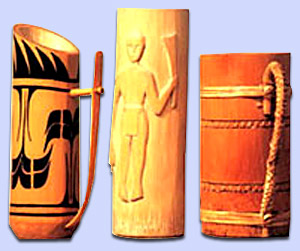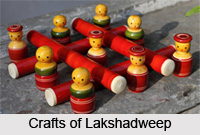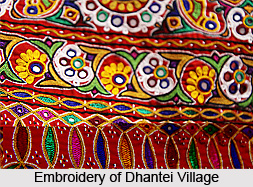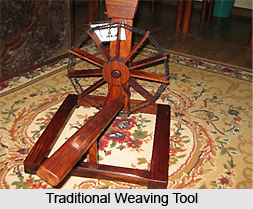 The weaving and dying craft is the process of making cloth which is made by crossing two sets of threads over and under each other. The two sets of threads are called warp and weft. The saree, popular apparel amongst Indian women, is a part of the weaving and dying craft. Many varieties of shining threads are immersed in dyes before weaving. This entire process constitutes the weaving and dying craft. Natural dyes like the indigo are used widely since the ancient times. However, in modern times the chemical dyes are gaining priority over the vegetable and mineral dyes.
The weaving and dying craft is the process of making cloth which is made by crossing two sets of threads over and under each other. The two sets of threads are called warp and weft. The saree, popular apparel amongst Indian women, is a part of the weaving and dying craft. Many varieties of shining threads are immersed in dyes before weaving. This entire process constitutes the weaving and dying craft. Natural dyes like the indigo are used widely since the ancient times. However, in modern times the chemical dyes are gaining priority over the vegetable and mineral dyes.
Different forms of Weaving and Dyeing Craft
The styles of weaving and dyeing craft vary depending upon the cultural tradition of the place, climatic conditions, cultural influences and business contacts. India has a wide range of textiles of varied designs that are manufactured by numerous techniques when compared to other countries in the world. Weaving and dyeing is done in India with the help of different materials and each state has its own style. For instance, the weaving and dyeing style of East India has a huge variety in the usage of materials like the silks brocades whereas cottons are prevalent in the West.
Bandhani style
The Bandhani and Tie-and-Dye culture is popular in the states of Rajasthan, Gujarat and Madhya Pradesh. This pattern is followed by intricate designs made by the womenfolk of the states. The Bandhani work is highly acclaimed in the centers like Kutch, Mandvi and Bhuj. Moreover, the Khatri community of Gujarat is known for their fine quality dyeing. Kutch is a well known centre for some sarees like the Gharchola sarees that bear tied and dyed patterns.
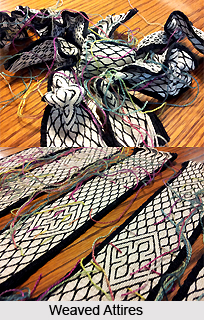 Traditionally bought for weddings, these sarees carry a gold thread for the checks with small golden motifs like peacock or lotus in the center. Rajkot in Saurashtra and Jamnagar are other important centers for Bandhanis. Jodhpur, Jaipur and Sikar in Rajasthan are famed for their Bandhani and Tie and Dye work in India.
Traditionally bought for weddings, these sarees carry a gold thread for the checks with small golden motifs like peacock or lotus in the center. Rajkot in Saurashtra and Jamnagar are other important centers for Bandhanis. Jodhpur, Jaipur and Sikar in Rajasthan are famed for their Bandhani and Tie and Dye work in India.
Mothra and Lahriya style
Mothra and Lahriya techniques are some of the other well known techniques of Rajasthan. The techniques and styles are different in Bihar and are worked to create bold patterns in single colors. The same technique is used in Madurai in Tamil Nadu to produce the famous Sungudi saris, which are a must for many communities during marriages in the South.
Patola style
The tie and dye technique of threads before weaving is known as Patola which is internationally known as Ikat. This type of weaving is done in Andhra Pradesh and Odisha. In Andhra it is known as Pagdu Bandha Baddabhasi or Chilka. Ikat furnishing weaving is done in the whole of Nalgonda district of Andhra. Moreover, Odisha has a distinctive style of Ikat popularly known as Bandha.
Batik style
Another well admired weaving and dying process is known as Batik that involves painting of the fabric with molten wax and then dying in cold dyes. This is said to be one of the most ancient techniques of weaving and dying process, carrying the tradition of 2000 years. Batik is done on a large scale in Madhya Pradesh and the items of this process include multi-colored batik saris, dupattas and bed sheets which are popular for their contrasting color schemes.
Textile printing craft
Block-printing, on the other hand includes hand printing which is widely practiced in Jaipur, Sanganer, Bagroo, Apli and Barmer in Rajasthan. In Gujarat, Mandvi, Dhamardhka, Mundra, Anjar, Jamnagar, Surrendranagar, Jaitpur, Ahmedabad, Baroda and Deesa are the important centers of printing fabrics. Mandvi and Anjar in Kutch district of Gujarat use both direct printing as well as resist printing.
Delhi and Farukhabad in Uttar Pradesh are also famous for printing establishments. Including these, Mausilipatnam in Andhra Pradesh has printers who are specialized in hand printing, Kalamkari printing, Resist printing, block printing and Batik works as well. Tanjore in Tamil Nadu produces fine quality hand printed saris with the resist method in a village which is called Kodial.
Jamdani style
The weaving and dyeing craft has got a distinct style in West Bengal with cotton. These sarees are called Jamdani and they follow the traditional patterns of weaving which is still practiced in Tanda and Varanasi. This Jamdani technique of patterning is found in the cotton centers of Venkatagiri in Andhra, Morangfi in Manipur and Kodialkarruppar in Tamil Nadu as well. Maheshwar on the banks of the river Narmada weaves fine cotton sarees with tiny checks, the Illkal sarees of Karnataka and the Narayanpet sarees of Andhra also follow the same style.
Gold brocade style
The weaving and dyeing craft has been recognized in Varanasi due to its associated famous silk weaving centers. The specialty of the region is the heavy gold brocade, which has an extra weft of rich gold thread running across the warp threads. Varanasi is preferred for the Amru silk brocades which are the Butidar ones enclosed by a border and a heavy pallu of flowering bushes or the flowing mango pattern.
Baluchar style
Another technique which is based upon the miniature paintings of India is Baluchar technique of Murshidabad district of West Bengal. The technique is popular in sarees known as Baluchari sarees.
Other weaving styles
There are some of the places where weaving and dyeing craft in cotton saree is considered of attracting the fancy of the people like Gadwal, Wanaparti, Nander and Venkatagiri. Even the cotton sarees produced in Tamil Nadu closely resemble the silk ones and the centers where these saris are manufactured are Kanjeevaram, Salem, Pudukottai and Madurai. Coimbatore has its own style which are less expensive and which resemble the Chanderi patterns. Nowadays cotton sarees woven with the traditional silk patterns called Kalakshetra is widely popular. The cotton sarees of Kerala are popular as Karalkudi. These are made of unbleached cotton with rich broad gold borders and pallus have become popular nowadays.
Apart from these, Ridrol in Mehsana District and Jamnagar in Saurashtra in Gujarat have centers of silk weaving. South India has a distinct class of its own in silk sarees. Kancheepuram, Tanjore and Kumbakonam are the important silk centers in Tamil Nadu. Sangareddy in Andhra, Kolegal and Molkalmoru in Karnataka are also famous silk weaving centers. Tanjore is specialized in weaving the all over gold sarees used for weddings and temple uses. Molkalmoru has its own distinct tradition of simple Ikat weave combined with a rich gold border carrying stylized motifs.
Folk Embroidery in India
Folk Embroidery in India is closely associated with the native culture, religion, and environment of the places. In India, embroidery work is done by the folk women of the region. The Rabaris of Kutch district in Gujarat does some of the finest embroidered decorations for the camel. The embroidery has different divisions among which applique work called Dharaniya is famous in all over the country. Embroidered Torans are put on the walls during festivals. The Mutwa women of the Banni area of Kutch have a distinct style of embroidery. Bikaner has a distinct style of embroidery, which is prepared on woolen ordhnis with woolen thread. They stimulate the Bandhani effect.
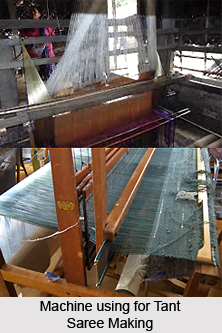 Punjab is the abode of Phulkari work. The hill areas of Himachal Pradesh produce double-sided embroidery known as Chamba Rumal. This may be of the simple folk type or the classical form, which has simplified versions of miniature paintings of Pahari. Appliqué work of Odisha and embroidery work of Bihar are famous for their creations. The Kasuti embroidery of Karnataka is a stylized form with stitches based on the texture of the fabric. Negi, Gavanti and the Menthi are the three different types of stitches used. Embroidered bead work is another distinct work of Indian weaving and dyeing craft.
Punjab is the abode of Phulkari work. The hill areas of Himachal Pradesh produce double-sided embroidery known as Chamba Rumal. This may be of the simple folk type or the classical form, which has simplified versions of miniature paintings of Pahari. Appliqué work of Odisha and embroidery work of Bihar are famous for their creations. The Kasuti embroidery of Karnataka is a stylized form with stitches based on the texture of the fabric. Negi, Gavanti and the Menthi are the three different types of stitches used. Embroidered bead work is another distinct work of Indian weaving and dyeing craft.
Shawl embroidery in India
The weaving and dyeing craft in India includes the rich tradition of shawls which are made of superfine quality wool with intricate designs and excellent workmanship. Kashmir is the workshop of a range of shawls like the Kani shawl, the double colored Pashima, the soft Santoosh, the majestic woolen shawl, the Dhussa, the men`s long shawl with its woven border and the fine Ambli or embroidered shawls. The intricate designs of Kani shawls, the double-sided shawl called Dorukha, the Aksi shawl are exemplary of the creativity of the people of Kashmir. The Himalayan region also produces many other varieties of shawls and tweeds for local usage. The shawls carry motifs inspired by the Buddhist traditions, the swastika, etc.
The weaving and dying craft in India has gained popularity for its creative and intricate designs with material of good quality. In recent times the items that are made out of weaving and dyeing process have made their way to international markets. The government has taken necessary initiatives for promoting this craft in all over India and abroad.



